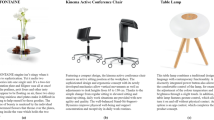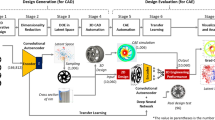Abstract
The quest for completely automated process planning systems has exposed the lack of techniques capable of automatically understanding the stored CAD models in a manner suitable for process planning. Most current generations of process planning systems have used the ability of humans to translate the part drawing requirements into a form suitable for computer aided process planing. Recently, research advances have been made to improve the understanding of computer stored 3-D part models. The two approaches used are feature recognition and feature based design. This paper presents a state of the art review of feature recognition techniques developed and presents feature based design as an alternative. Process planning systems developed using both approaches are presented.
Similar content being viewed by others
References
Alting, L. and Zhang, H. (1989) Computer aided process planning: the state of the art survey.International Journal of Production Research 27, 553–85.
Armstrong, G. T., Carey, G. C. and de Pennington, A. (1984) Numerical code generation from a geometric modeling system, inSolid Modeling by Computers, pp. 139–57 (edited by Picket, M. S. and Boyse, J. W.). New York: Plenum Press.
Bond, A. H. and Chang, K. J. (1988) Feature based process planning for machined parts, inProceedings of the ASME International Computers in Engineering Conference, vol. 1, pp. 571–6, San Diego, CA.
Bond, A. H. and Jain, R. (1988) A formal definition and automatic extraction of group technology codes, inProceedings of the ASME International Computers in Engineering Conference, vol. 1, pp. 537–42. San Diego, CA.
CAM-I (1980)Glossary of Features Computer Aided Manufacturing International, Arlington, Texas.
Chang, T. C., Anderson, D. C. and Mitchell, O. R. (1988) QTC-an integrated design/manufacturing/inspection system for prismatic parts, inProceedings of the 1988 Computers in Engineering Conference, San Francisco, August 1–4.
Choi, B. K. (1982) CAD/CAM compatible tool oriented process planning system. Ph.D. Thesis School of Industrial Engineering, Purdue University, W. Lafayette, IN.
Choi, B. K., Barash, M. M. and Anderson, D. C. (1984) Automatic recognition of machined surfaces from a 3-D solid model.Computer Aided Design 16, 81–6.
Cunningham, J. J. and Dixon, J. R. (1988) Designing with features: the origin of features, inProceedings of the ASME International Computers in Engineering Conference, vol. 1, pp. 237–43. San Diego, CA.
Dong, X. and Wozny, M. (1988a) FRAFES: a frame based feature extraction system, inProceedings of International Conference on Computer Integrated Manufacturing. Rennselaer Polytechnic Institute Troy, NY. May 23–25.
Dong, X. and Wozny, M. (1988b) Feature extraction and computer aided process planning, inProceedings of the Third International Conference on Computer Aided Production Engineering, University of Michigan, June 1–3.
Fagan, D. J. (1986) Extraction and organizing of manufacturing features from a three dimensional CAD database. MS Thesis, Purdue University, W. Lafavette, IN.
Falcidieno, B. and Giannini, F. (1987) Extraction and organization of features into a structured boundary model, inProceedings of Eurographics '87 Amsterdam, Holland, pp. 249–59.
de Floriani, L. (1989) Graph based approach to object feature recognition, inProceedings of Third ACM Symposium on Computational Geometry, Waterloo.
Fridshal, R. (1988) Presentation at the NSF Workshop on Features in Design and Manufacturing, UCLA, CA, Feb. 1988.
Grayer, A. R. (1977) The automatic production of machined components starting from a stored geometric description, inAdvances in Computer Aided Manufacturing, pp. 137–51 (edited by McPherson, D.). Amsterdam: North Holland Publishing Co. Ltd.
Henderson, M. R. (1984) Extraction of feature information from three-dimensional CAD data. Ph.D. Thesis, Mechanical Engineering, Purdue University, W. Lafayette, IN.
Henderson, M. R. (1986) Automated group technology coding from a three-dimensional CAD database, inBound Volume of the Symposium on Knowledge Based Expert Systems for Manufacturing, pp. 195–204, The Winter Annual Meeting of ASME, Anaheim, CA.
Henderson, M. R. and Anderson, D. C. (1984) Computer recognition and extraction of form features: A CAD/CAM link.Computers in Industry 5, 329–39.
Henderson, M. R. and Chang, G. J. (1988) FRAPP: automated feature recognition and process planning from solid model data, inProceedings of the ASME International Computers in Engineering Conference, vol. 1, pp. 529–36, San Diego, CA.
Hirschtick, J. K. and Gossard, D. C. (1986) Geometric reasoning for design advisory systems, inProceedings of the ASME International Computers in Engineering Conference vol. 1, pp. 263–70, Chicago, July 1986.
Iwata, K., Kakino, Y., Oba, F. and Sugimura, N., (1980) Development of non-part family type computer aided production planning system, inAdvances in Manufacturing Technology, pp. 171–84 (edited by Blake, P.), Amsterdam: North Holland Publ. Co.
Jakubowski, R. (1980) Syntactic characterization of machine parts shapes.Cybernetics and Systems: An International Journal,13, 1–24
Jared, G. E. M. (1984) Shape features in geometric modeling, inSolid Modeling by Computers: From Theory to Applications, pp. 121–37 (edited by Picket, M. S. and Boyse, J. W.) New York: Plenum Press.
Joshi, S. (1987) CAD interface for automated process planning. Ph.D. Thesis, School of Industrial Engineering, Purdue University, W. Lafayette, IN.
Joshi, S. and Chang, T. C. (1988) Graph based heuristics for recognition of machined features from a 3-D solid model.Computer Aided Design 20, 58–66.
Joshi, S., Vissa, N. N. and Chang, T. C. (1988) Expert process planning system with solid model interface.International Journal of Production Research 26, 863–85.
Kals, H. J. J. and van't Erve, A. H. (1986) XPLANE: a generative process planning system for part manufacturing.Annals of CIRP 35.
Kanumury, M., Shah, J. and Chang, T. C. (1988) An automated process planning system for a quick turn around cell-an integrated CAD and CAM system, inProceedings of USA-Japan Symposium on Flexible Automation, Minneapolis, Minnesota, July 18, 1988.
Kennington, W. R. and Kimball, B. M. (1988)Feature Recognition: Rule Based Interpretation of CAD Data.
Kung, H. (1984) An investigation into development of process plans from solid geometric modeling representation, Ph.D. Thesis, Oklahoma State University.
Kyprianou, L. K. (1980) Shape classification in computer aided design. Ph.D. Thesis, University of Cambridge, UK.
Lee, Y. C. and Fu, K. S. (1987) Machine understanding of CSG: extraction and unification of manufacturing features.IEEE Computer Graphics and Applications 7, 20–32.
Libardi, E. C., Dixon, J. R. and Simmons, M. K. (1986) ‘Designing with features design and analysis of extrusions as an example’, ASME Paper No. 86 DE-4, presented at the ASME Design and Engineering Conference, Chicago, March 1986.
Liu, C. R. and Srinivasan, R. (1984) Generative process planning using syntactic pattern recognition.Computers in Mechanical Engineering 2, 63–6.
Luby, S. L., Dixon, J. R. and Simmons, M. K. (1986) Designing with features: creating and using a features database for evaluation of manufacturability of castings, inProceedings of the ASME Computers in Engineering Conference, vol. 1, pp. 285–92, Chicago, July 1986.
Mashburn, T. A. (1987) A polygonal solid modeling package. MS Thesis, Department of Mechanical Engineering, Purdue University, 1987.
Milacic, V. R. (1985) SAPT — expert system for manufacturing planning, inComputer Aided/Intelligent Process Planning (edited by Liu, C. R., Chang, T. C. and Komanduri, R.). ASME Winter Annual Meeting, PED-Vol. 19, ASME, 1985.
Miner, R. H. (1985) A method for the representation and manipulation of geometric features in a solid model. MSc. Thesis, Dept. of Mechanical Engineering, Massachusetts Institute of Technology, May 1985.
NSF Workshop on Features in Design and Manufacturing, UCLA, Feb. 1988.
Ostrowski, M. C. (1986) A method for feature-oriented design using constructive solid geometry. GE Corporate Research and Development Center. Schenectady, NY, 1986.
Pratt, M. J. (1988) Synthesis of an optimal approach to form feature modelling, inProceedings of the ASME International Computers in Engineering Conference, San Diego, CA, vol. 1, pp. 263–74, 1988.
Requicha, A. A. G. (1980) Representation of rigid solids: theory, methods, and systems.Computing Surveys 12, 437–64.
Sakurai, H. and Gossard, D. C. (1988) Shape feature recognition from 3-D solid models, inProceedings of the ASME International Computers in Engineering Conference, San Diego, CA, vol. 1, pp. 515–9, 1988.
Shah, J., Bhatnagar, A. and Hsiao, D. (1988) Feature mapping and application shell, inProceedings of the ASME International Computers in Engineering Conference, San Diego, CA, vol. 1, pp. 489–96.
Srinivasan, R., Liu, C. R. and Fu, K. S. (1985) Extraction of manufacturing details from geometric models.Computers and Industrial Engineering 9, 125–34.
Staley, S. M., Henderson, M. R. and Anderson, D. C. (1983) Using syntactic pattern recognition to extract feature information from a solid modeling database.Computers in Mechanical Engineering 2, 61–5.
Willis, D., Donaldson, I. A., Ramage, A. D., Murray, J. L. and Williams, M. H. (1989) A knowledge based system for process planning based on a solid modeller.Computer Aided Engineering Journal, pp. 21–6, Feb. 1989.
Woo, T. C. (1977) Computer aided recognition of volumetric designs, inAdvances in Computer-Aided Manufacturing, pp. 121–35 (edited by McPherson, D.). Amsterdam: North Holland Publishing Co. Ltd.
Woo, T. C. (1983) Interfacing solid modeling to CAD and CAM: data structures and algorithms for decomposing a solid. Technical Report 83-6. Department of Industrial and Operations Engineering, University of Michigan, Ann Arbor, 1983.
Woodwark, J. R. (1988) Some speculations on feature recognition.Computer Aided Design 20, 189–96.
Author information
Authors and Affiliations
Rights and permissions
About this article
Cite this article
Joshi, S., Chang, TC. Feature extraction and feature based design approaches in the development of design interface for process planning. J Intell Manuf 1, 1–15 (1990). https://doi.org/10.1007/BF01471338
Issue Date:
DOI: https://doi.org/10.1007/BF01471338




